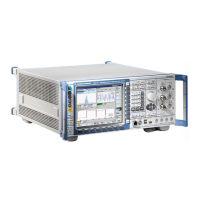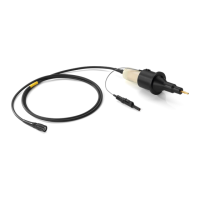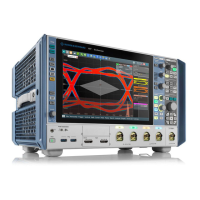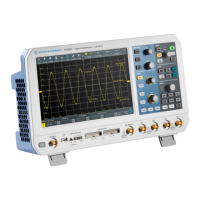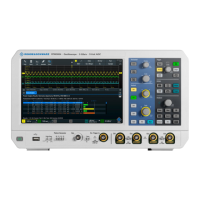CMU Status Reporting System
1100.4903.12 5.25 E-8
Symbolic Status Event Register Evaluation
The examples for status register handling given in section Service Request on p. 5.24 are based on a
step-by-step evaluation of the STATus:OPERation register and its sub-registers. As a convenient
alternative to this approach, the CMU provides commands for symbolic status event register evaluation.
These commands are global (i.e. available in all function groups) and described in detail in Chapter 6.
They organize and simplify the following actions:
STATus:OPERation:EVENt:SADDress?
Return the next secondary address and associated
function group where an event was reported.
STATus:OPERation:SYMBolic:ENABle
<Event_1>[,<Event_2>,...<Event_15>]
Enable the events of the parameter list up to the
status byte, i.e. set the corresponding bits in the
STATus:OPERation:ENABle register and in the
sub-registers
STATus:OPERation:CMU:SUM1|2:ENABle and
STATus:OPERation:CMU:SUM1|2:CMU <Se-
cAddr>:ENABle so that the events are reported in
the status byte. <SecAddr> denotes the current sec-
ondary address, see also example in section Service
Request on p. 5.24.
STATus:OPERation:SYMBolic[:EVENt]?
Return all events reported in the current function
group. The event symbols listed with the bit assign-
ment of the STATus:OPERation... registers; for
an example see Table 5-5 on page 5.22.
A program example for symbolic status register evaluation is included in chapter 7 of this manual.
Serial Poll
In a serial poll, just as upon the command "*STB", the status byte of an instrument is queried. However,
the query is made via interface messages and is thus clearly faster. The serial-poll method has already
been defined in IEEE 488.1 and used to be the only standard possibility for different instruments to poll
the status byte. The method also works for instruments which do not adhere to SCPI or IEEE 488.2.
The quick-BASIC command for executing a serial poll is "IBRSP()". The serial poll is mainly used to
obtain a fast overview of the state of several instruments connected to the GPIB bus.
Parallel Poll
In a parallel poll, up to eight instruments are simultaneously requested by the controller by means of a
single command to transmit 1 bit of information each on the data lines, i.e., to set the data line allocated
to each instrument to a logic "0" or "1". By analogy to the SRE register which determines under which
conditions an SRQ is generated, there is a parallel poll enable register (PPE) which is ANDed with the
STB bit by bit, considering bit 6 – AND as well. The results are ORed, the result is then sent (possibly
inverted) as a response to the parallel poll of the controller. The result can also be queried without par-
allel poll by means of the command "*IST".
The instrument first has to be set for the parallel poll using the quick-BASIC command "IBPPC()". This
command allocates a data line to the instrument and determines whether the response is to be in-
verted. The parallel poll itself is executed using "IBRPP()".
The parallel-poll method is mainly used in order to quickly find out after an SRQ which instrument has
sent the service request if there are many instruments connected to the GPIB bus. To this effect, SRE
and PPE must be set to the same value.
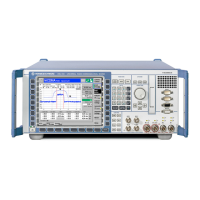
